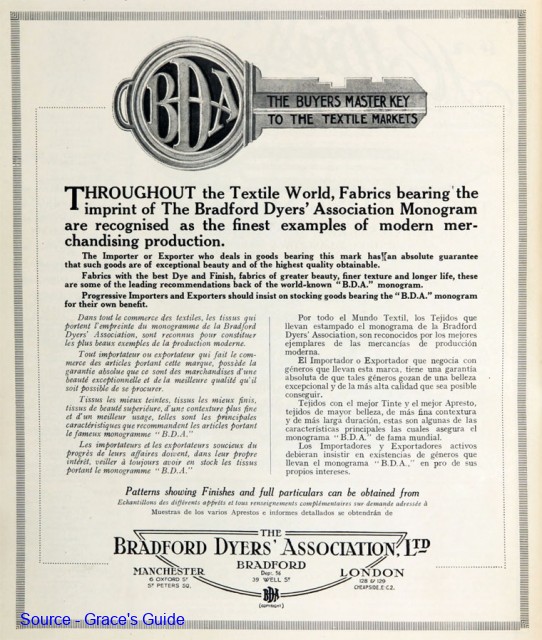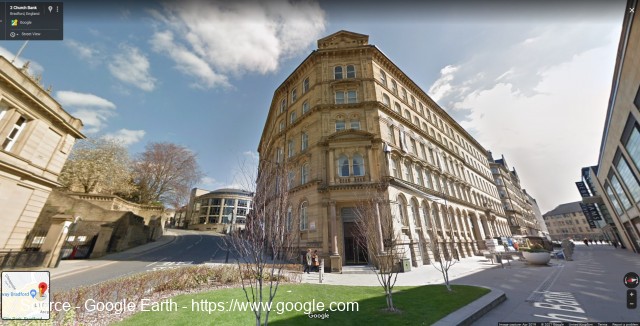Description and History of Site:-
The headquarters of the BDA - Bradford Dyers Association was a five storey sandstone building that stood at the foot of Church Bank at 39 Well Street, an organisation that brought together the dyeing and finishing processes of 22 Bradford firms and comprised about 90% of the city's piece-dyeing trade with a combined workforce of 7,500. Chairman James Ewing said in a report published in March 1949 that the company had been formed to pool technical skills and experience and the centralisation of administration, purchasing, distribution and accountancy. He said the idea was to stabilise prices by agreement so as market forces fluctuated, all parties would make a profit, in effect the organisation was a cartel. The organisation was international with branches in Egypt, the USA and Canada who produced 50% of the companies trading profit.
The headquarters also contained a top floor laboratory where chemists and technicians worked on developing the finishing processes that proofed fabrics against fading, shrinking and creasing. The association was a forerunner in the finishing and dyeing of rayon crepes, wool and cotton fabrics including a process called Maxifix, a process which made wool fabrics shrink resistant during washing and wear. During the second half of the 20th century as synthetic fibres displaced natural fibres, BDA developed water-proofing, moth proofing, rot-proofing and flame-retarding for the new fibres coming to market - Nylon Polyester. The BDA was founded in December 1898 when 22 Bradford businesses, including Edward Ripley and Son in East Bowling, Bradford (reputedly the largest dye works in the world) were acquired for the then huge sum of £2,870,640.
George William Douglas (-1947) of Edward Ripley and Son and founder member of the Society of Dyers and Colourists, who became a hugely influential figure in Bradford's textile industry, helped to create the BDA and became its Chairman and also from 1909 until his retirement in 1946, Managing Director.
In 1956 Egypt's President Nasser sequestrated the assets of BDA's Alexander company Beida Dyers which in 1954 had processed 81,000,000 yards of cloth, mainly high quality shirting fabric. When Nasser struck the blow for Egyptian Nationalism he badly wounded BDA. Compensation claims to the Foreign Office were submitted totalling £3.25m, not settled until 1963 and then only receiving one third of the claim.
In 1964 BDA was acquired by Manchester's Viyella International and subsequently by ICI who merged the company with Coats Paton which became Coats Viyella. In 2003 that company was taken over by Guinness Peat Group and registered as Coats PLC. The former headquarters are still standing and are now converted into apartments.
Further Reading and References:-https://www.thetelegraphandargus.co.uk/tahistory/10074656.prestige-and-power-of-a-material-world/
Help us improve this entry
The compilers welcome corrections or additional information on all sites.
Any information provided will be verified before appearing on the web site.
Email comments
Key Words :- textile dyers
Viewing the Site :- Public footpath alongside the site.
Address :- 39 Well Street, Bradford, West Yorkshire, BD1 5NE
Grid Ref :- SE 16688 33176
Co-ordinates :- Lat 53.794629 , Long -1.748148
Local Authority :- City of Bradford
Pre 1974 County :- Yorkshire - West Riding
Site Status :- Site extant - Protected status unknown
Site Condition :- Site refurbished to residential housing
Site Dates :- 1898 - -
Record Date :- 16 March 2021
Copyright :- cc-by-nc-sa 4.0 © Andrew Garford
Grid Ref :- SE 16688 33176
Co-ordinates :- Lat 53.794629 , Long -1.748148
Local Authority :- City of Bradford
Pre 1974 County :- Yorkshire - West Riding
Site Status :- Site extant - Protected status unknown
Site Condition :- Site refurbished to residential housing
Site Dates :- 1898 - -
Record Date :- 16 March 2021
Copyright :- cc-by-nc-sa 4.0 © Andrew Garford

